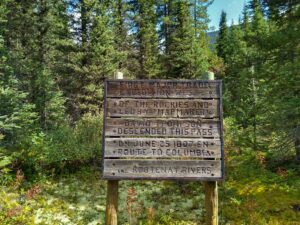by Bethany Hughes
Six months ago we were turning past a forest fire burning just off highway 16 on our way up to Kakwa trailhead, where we hiked into a hailstorm to begin the Great Divide Trail. Making a bid on a south bound, autumn thru-hike, we were grateful for every sunny moment. We listened with great curiosity to trail reports from those who were finishing their northbound hikes on that particularly dry summer and we read with great amusement the vastly differing comments in the apps from those who had passed months or weeks before. Today I write this from the birdsong bathed banks of Lake Atitlán while bikepacking across Guatemala and am dizzied at what a difference a bit of time makes to one’s perspective.
There is grounding in letting the past inform the present to set a trajectory for the future. At 52 years young, the journey of the Great Divide Trail from inception to present day is rich with lessons and potential. Enough to keep a hiker mulling for many a mile. Or, If you are not able to get out on the trail and chew the cud yourself, Jenny Feick’s text Tales from the Great Divide Trail affords humor and perspective.
As a US Citizen, one of the things which enamored me of the origin story of the GDT is the effect of youth organizations, such as the Girl Guides and OFY (Opportunities for Youth) program in the early days of the GDT in the 1970s. At that time, Canada was generating immeasurable ROI for a pittance of national investment, creating deeply explored routes and some of the most hardy and dedicated ecologists and travelers I’ve ever walked and talked with. Even as I plot our Her Odyssey route north of the GDT, along the Arctic Drainage, some of the canoeing texts I use also cite the OFY Program as their starting point.
This is what funding imaginative dreamers and hard workers generates and we experience the yields of it at each variable turn in the trail. The shifting character of the sections reflects the time periods in which they were built. Most notably, sections B and C, side by side, the oldest and youngest examples of GDTA trail work. It drives the lessons into your muscle and sinew to walk through the rapid development and adaptation of trail building techniques.
Running deeper still, into time immemorial, how this trail overlaps the routes of the First Nations is testament that, as a species, we may change but not that much. Further north, in what I affectionately liked to call “Sections eFfinG” where the trail pays homage to those first human footways through the willows, fens, and valleys, the work feels more primal. Tiny humans begging our way through the laps and groveling at the feet of an eminent ocean of peaks. I reflected a great deal on the dynamic of humiliation and humility along those first 180 miles and now, from a safe distance and warm sunny spot, am immeasurably grateful.
The trail itself abounds with analogies and lessons. That sometimes a lower grade and longer route create a more sustainable path. That giving people options allows adaptation while cultivating independence and ingenuity. That ongoing investment and maintenance are necessary for a vision to become reality. That sharing, both takes a toll and forges alliances for holding ground down the road. That our greatest aspirations are at the mercy of the shifting face of this planet and patience and observation are as powerful of tools as ambition and action.
As you set sole and shovel to trail this summer, know it waits with opportunity for reflection, as full of potential growth as a blister is with fluid. I love knowing that I could come back and hike the GDT again and be on an entirely different trail. Enjoy these last few months to reflect on where this trail has come from, and center your focus, for your work this season forges the way forward.



